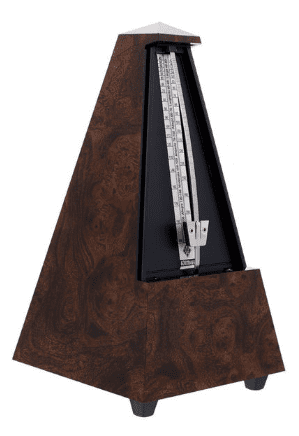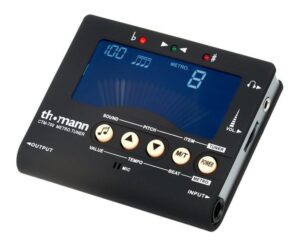Today we are going to focus on very basic things. Rent, health insurance, earning your daily bread… and the like. What does bass playing have to do with it? A lot, at least if you are a professional player and have to pay the above mentioned things with your wages. And the more jobs you have, the higher they are. And the better you are and the more connected you are (socially), the more jobs you have, but that’s another story… ?⌛
Better timing, better groove
And now we finally come to the topic: What does “better” mean? And how can this little metronome gadget help us improve? Don’t underestimate the metronome! It’s one of our best friends if you use it well. And it is used specifically to develop better timing and thus a better feeling of the groove. Your colleagues love you for your groove on the lower seven frets, not for the racy 16th note slaps or the high-flying, fuzzy solos…
You are currently viewing a placeholder content from Giphy. To access the actual content, click the button below. Please note that doing so will share data with third-party providers.
Better groove thanks to the metronome
Your groove depends on your ability to play notes “dead on”, to the millisecond. “Those are details you can’t even hear”, you’ll say, and you’re right about that. “Not many people in the audience will notice that”, you might also say. Hmmmm, that’s no longer true. Five milliseconds behind or ahead are perhaps not very audible, but they are noticeable. And they make the difference between drifting, rushing, grooving, laying-back or dragging.
Such accuracy is not innate, you have to work on it! This is even possible with relatively little effort. You need a precise metronome and 5 minutes of time. But you need it regularly, DAILY.
How it works
For the first exercise, set your metronome to a medium tempo, such as 120 bpm (beats per minute). Select any note on your bass, preferably an open string, and concentrate exclusively on your touch. Now try to catch the click of the metronome precisely, every time.
How exact is it? An acoustic phenomenon helps us. If we are exactly “on the click”, we don’t hear it anymore. Literally, it will be gone. It’s a strange feeling the first time that you’ll probably fall out right away. Then it’s there again, the click.

Will you be able to maintain this state for a few bars? The next step is to change the tempo to 85 bpm for example. Or 130 bpm. And try it from the beginning. You’ll notice that the faster the tempo, the harder it gets – as expected. But the lower the tempo, the more difficult it gets as well! 40 bpm is a real challenge (there is more room – or time – for error)!
As soon as we start hitting the click constantly, virtually every time, we can play around with it a bit. Try to leave the safe harbour of the click and play consciously ahead or behind it. This is less a matter of will than of feeling. Strange as it may sound, if you lean a bit forward or backwards you can influence your groove accordingly. If you want to know exactly, you can also connect bass and metronome to two different channels of a DAW (Logic, Cubase, Ableton Live, etc.). There you can see just how accurate your “feeling” is.
When you’re ready, you should apply your newly developed skills to your grooves. Especially when you go beyond the pure 1/4 or 1/8 level, it gets a little more difficult. Take this groove for instance:

At first the half note after the eighth note might be played too late. But that’s okay – practising is a very sure way to get better (and to be better booked and better paid). By the way, this also applies to non-professionals.
The path to rock-solid timing
Once you’ve overcome these hurdles you’re on your way to rock solid timing and feeling. After, let’s say, half a year of consistent (!) practice, you’ll be locked in. By the way, one of the biggest masters of groove, Victor L. Wooten, wrote “Music Lessons: A Spiritual Search for Growth Through Music” a highly-recommended book. It’s more of a novel than a textbook and less esoteric than the title may suggest.
Metronomes
Since this article is all about metronomes, we can’t forget about the products themselves. Here is just a small selection of metronomes in our shop:
- Thomann Metronom 330
- Wittner Metronome 813M with Bell
- Korg KDM-3 Dig. Metronom Limited
- Korg TM-60 White
- Korg TM-60 Black
- KORG MA-2 BKRD
























Comments 1